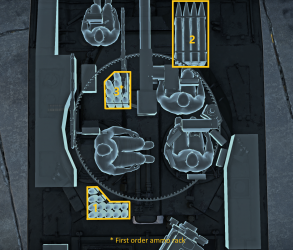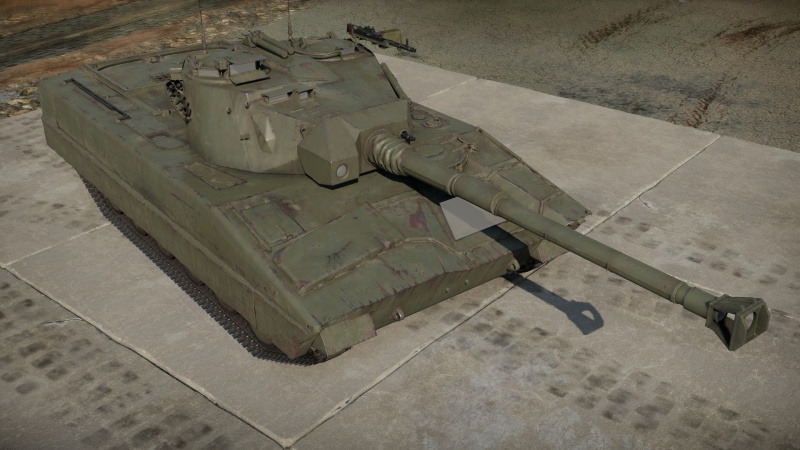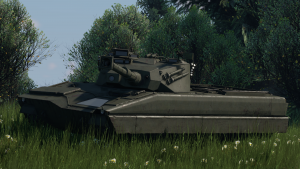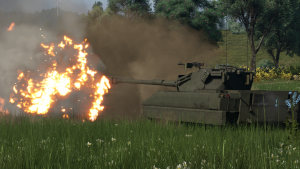Ikv 91-105
| This page is about the Swedish light tank Ikv 91-105. For the 90 mm variant, see Ikv 91. |
Contents
Description
The ikv 91-105 was an upgrade program meant to fulfil the needs of the Indian army for a new amphibious light tank. Although it never reached production or service with any army, it was considered by Sweden as an upgrade for their regular ikv 91s. SAAB fully developed the program, it included a new super-low-recoil 105 mm gun provided by Rheinmetall, since the vehicle could not sustain the pressure from more advanced 105 mm cannons. The commander and gunner also received new fire control systems, with IR night vision devices provided by SAAB. While India considered the tank, the vehicle was never adopted, and the same could be said about the Swedish Army, that considered the tank too weak for such weaponry, and instead used the strv 122 and strf 90 to fulfil the role of the ikv 91 in the following years.
Introduced in Update "Ixwa Strike", the Infanterikanonvagn 91-105 has access to a set of very decent characteristics at its BR. For example, while it may lack advanced fire control systems with thermal sight, it does have very good mobility, making it a very lethal light tank if it tries to flank main enemy columns. Its best round, the slpprj m/80 has good penetration values, and coupled with its two-axis stabilizer and a laser rangefinder, it will be one of the first to shoot if it acquires a target fast enough. Gun depression is good enough at -8 degrees, which makes it capable of attacking over hills and mountains. It should be noted that the reverse speed is not great, and it should use its smoke launchers when reversing to avoid getting stuck in a bad position.
General info
The Ikv 91-105 is a Swedish light tank that offers accurate firepower with good mobility. The gun fires highly devastating APFSDS rounds that can effectively deal with targets opposing it around flanking routes and open fields. The tank relies heavily on shooting first, as the vehicle features little protection to save it. This requires the user to creatively position the vehicle so enemies are ensured to be shot first, to avoid any possible incoming damage. The gun is well equipped with a two-plane stabilizer and laser rangefinder, which guarantees a perfect shot at any range when used properly. As a secondary line of defence, the Ikv 91-105 features a good amount of smoke grenades that quickly deploy high above the tank, allowing it to very effectively escape either by reversing or swiftly turning around.
Overall, the Ikv 91-105 is a great tank for anyone already used to the Ikv 91 looking for a modernized alternative, as well as for anyone interested in a conventional light tank at this high rank.
Survivability and armour
The Ikv 91-105 is a light vehicle. In order to remain agile, the Ikv 91-105 is forced to sacrifice most of its protection. The hull and turret sport a different shape compared to the earlier Ikv 91, but overall maintain the same level of protection. The upper and lower plates can occasionally protect against .50 cal MG fire, but the turret is often left exposed. The Ikv 91-105 should always avoid incoming fire from large-calibre machine guns and cannons, as they are more than likely guaranteed to damage the tank internally.
Armour type:
- Rolled homogeneous armour (hull, turret)
- High-hardness rolled homogeneous armour (hull sides, lower front plate)
| Armour | Front (Slope angle) | Sides | Rear | Roof |
|---|---|---|---|---|
| Hull | 12 mm (30-45°) Top 20 mm (37°) Bottom |
4 mm Top 8 mm Bottom |
8 mm (15°) Top 8 mm (20°) Bottom |
8-12 mm |
| Turret | 12 mm (0-50°) Turret front 12 mm (0-50°) Gun mantlet |
12 mm (10-40°) | 12 mm (0-30°) | 12 mm (0-15°) |
| Cupola | 12 mm | 12 mm | 12 mm | 12 mm |
Notes:
- Tracks are 15 mm thick, while suspension wheels and torsion bars are 20 mm thick.
- Belly armour is 10 mm thick.
Mobility
| Game Mode | Max Speed (km/h) | Weight (tons) | Engine power (horsepower) | Power-to-weight ratio (hp/ton) | |||
|---|---|---|---|---|---|---|---|
| Forward | Reverse | Stock | Upgraded | Stock | Upgraded | ||
| Arcade | Expression error: Unexpected * operator. | 558 | Expression error: Unexpected round operator. | __.__ | |||
| Realistic | 318 | Expression error: Unexpected round operator. | __.__ | ||||
Although the mobility of the Ikv 91-105 can come off as mediocre, the overall agility of the vehicle is very comfortable in battle. The tank is able to neutral steer without any issue, and has enough speed in both directions to avoid most situations. The engine is essentially identical to the prior Ikv 91, and thus struggles a lot when difficult slopes are encountered, considering the tank is significantly heavier than its original variant.
Modifications and economy
Armaments
Main armament
The 105 mm cannon found on the Ikv 91-105 is a two-plane stabilized gun, capable of firing sub-calibre munitions, such as the Slpprj m/80, that perform favourably against most vehicles it faces. Although the penetration might seem like a downgrade compared to the HEATFS found on the prior Ikv 91, the shells fired have a much higher velocity, and devastating penetration values at high angles.
The cannon is paired with a laser rangefinder, which automatically adjusts the elevation at range. This makes the Ikv 91-105 very capable at distanced engagements, as the gun can fire with perfect accuracy as soon as the target has been measured. The user still has to account for target movement, as well as objects or terrain obstructing the target. But when used carefully, the gun only really requires a single shot per target.
| 105 mm kan Bofors | Turret rotation speed (°/s) | Reloading rate (seconds) | |||||||||||
|---|---|---|---|---|---|---|---|---|---|---|---|---|---|
| Mode | Capacity | Vertical | Horizontal | Stabilizer | Stock | Upgraded | Full | Expert | Aced | Stock | Full | Expert | Aced |
| Arcade | 40 | -8°/+15° | ±180° | Two-plane | 23.8 | 32.9 | 40.0 | 44.2 | 47.1 | 8.71 | 7.70 | 7.10 | 6.70 |
| Realistic | 14.9 | 17.5 | 21.3 | 23.5 | 25.0 | ||||||||
Ammunition
| Penetration statistics | |||||||
|---|---|---|---|---|---|---|---|
| Ammunition | Type of warhead |
Penetration @ 0° Angle of Attack (mm) | |||||
| 10 m | 100 m | 500 m | 1,000 m | 1,500 m | 2,000 m | ||
| slpprj m/66 | APDS | 258 | 256 | 245 | 233 | 222 | 211 |
| slsgr m/61A | HE | 23 | 23 | 23 | 23 | 23 | 23 |
| slspgr m/61 | HESH | 127 | 127 | 127 | 127 | 127 | 127 |
| slpprj m/80 | APFSDS | 337 | 335 | 330 | 322 | 314 | 306 |
| Shell details | ||||||||||||
|---|---|---|---|---|---|---|---|---|---|---|---|---|
| Ammunition | Type of warhead |
Velocity (m/s) |
Projectile mass (kg) |
Fuse delay (m) |
Fuse sensitivity (mm) |
Explosive mass (TNT equivalent) (kg) |
Ricochet | |||||
| 0% | 50% | 100% | ||||||||||
| slpprj m/66 | APDS | 1,400 | 4.53 | - | - | - | 75° | 78° | 80° | |||
| slsgr m/61A | HE | 650 | 15.5 | 0 | 0.1 | 1.83 | 79° | 80° | 81° | |||
| slspgr m/61 | HESH | 720 | 11.4 | 0.1 | 4 | 3.15 | 73° | 77° | 80° | |||
| slpprj m/80 | APFSDS | 1,455 | 4.2 | - | - | - | 78° | 80° | 81° | |||
| Smoke shell characteristics | ||||||
|---|---|---|---|---|---|---|
| Ammunition | Velocity (m/s) |
Projectile mass (kg) |
Screen radius (m) |
Screen deploy time (s) |
Screen hold time (s) |
Explosive mass (TNT equivalent) (g) |
| rökgr m/61 | 330 | 18.7 | 20 | 5 | 25 | 50 |
Ammo racks

| Full ammo |
1st rack empty |
2nd rack empty |
3rd rack empty |
Visual discrepancy |
|---|---|---|---|---|
| 40 | 28 (+12) | 12 (+28) | 1 (+39) | No |
Notes:
- Shells are modeled individually and disappear after having been shot or loaded.
- Rack 3 is a first stage ammo rack. It totals 11 shells and gets filled first when loading up the tank.
- This rack is also emptied early: the rack depletion order at full capacity is: 3 - 1 - 2.
- Simply not firing when the gun is loaded will move ammo from racks 1-2 into rack 3. Firing will interrupt the restocking of the ready racks.
Machine guns
The Ikv 91-105 features two 8 mm machine guns. These are quite common for most Swedish tankers, and are only effective against exposed crew, and slow flying helicopters. The 8 mm rounds are quite effective at dealing with light obstacles like small fences and foliage, but should always be used with caution, as the tracers can expose the location of the vehicle.
| 8 mm ksp m/39B | ||||
|---|---|---|---|---|
| Mount | Capacity (Belt) | Fire rate | Vertical | Horizontal |
| Coaxial | 2,250 (250) | 649 | N/A | N/A |
| Pintle | 2,000 (250) | 649 | -5°/+15° | ±80° |
Usage in battles
When playing the Ikv 91-105, it's important to play like a light tank. The Ikv 91-105, although nimble, can be quite slow when stock. Overall the tank struggles to maintain a high speed, and will often lag behind other vehicles of the same class. The great compensation for this is the firepower. Thanks to a deadly arsenal of shells, along with a stabilizer, the tank engages any vehicle it faces with ease. Paired with a stabilizer and laser rangefinder, the Ikv 91-105 can comfortably attack at any distance. This makes the Ikv 91-105 very flexible, as you can use it both as a long range reconnaissance sniper, and a close range glass cannon.
When a match starts, it's always optimal to look for a favourable location within reach. If mobility allows you to surprise your opponents, it can be a favourable choice, especially in close quarter maps. While other situations could call for distanced engagements, such as unexpected sight-lines and well hidden ambushes, as the tank is fairly easy to hide. On top of its small profile, the Ikv 91-105 features a good amount of smoke launchers, that quickly deploy and conceal the vehicle when necessary.
A typical engagement scenario:
- Rush to a position with a favourable line of sight
- Engage opponents without exposing yourself
- Scout targets for your team
- Deploy smoke grenades to help your team retreat
Pros and cons
Pros:
- Hard-hitting 105 mm cannon
- Small profile, shorter than most tanks
- Great mobility and traverse
- Ability to scout
- Access to night vision devices
Cons:
- Lightly armoured, insufficient even to resist .50 cal MG fire
- Mediocre rate of fire
- Inconsistent depression angles, uncomfortable to aim behind cover
- Vulnerable to aircraft
History
AB Hägglunds & Söner, the company behind the ikv 91 light tank, had high hopes for a successful export market, outside the domestic use of the platform. The design had been ill-fated early since the chassis was too weak to handle high-pressure weaponry, necessary for sub-calibre munitions. By the 1980s however, the ability to mount a high pressure 105 mm cannon was taken to consideration, as Bofors had developed a low-recoil variant. This design idea quickly took shape in 1983 as India was looking for a new amphibious light tank. The requirements involved full firing capability when submerged, meaning the cannon had to be stabilized. The vehicle introduced a commanders fire control system, as well as Infra-red night vision devices provided by SAAB. The new gun was the Rheinmetall Rh 105-11 super-low recoil gun in a new turret. This increased the weight up to 2 tons, however the amphibious speed was also increased to 12 km/h thanks to a new engine.
India evaluated the design, along with other countries, but ultimately no series production was ever established. The Swedish Army considered a possible modernization of the ikv 91 by using this 105 mm gun with minor modifications, but it was never adopted. This was thanks to the end of the Cold War, and the fact that the design was considered too weak for modern times. Instead, its role would later be filled by the strv 122 and the strf 90 IFV.
Media
- Skins
- Videos
See also
Similar Swedish tanks
Similar tanks in terms of performance and BR
External links
| Hägglund & Söner | |
|---|---|
| Light Tanks | |
| Ikv 91 | Ikv 91 · Ikv 91-105 |
| Tank Destroyers | |
| ATGM Carriers | UDES 33 · Pvrbv 551 · Pbv 302 (BILL) |
| SPAA | |
| Strv m/41 | Pbv 301 |
| SAM | Lvrbv 701 |
| See Also | BAE Systems AB |
| Sweden light tanks | |
|---|---|
| L-60 | Strv m/38 · Strv m/39 · Strv m/39 TD · Strv m/40L |
| Strv m/41 | Strv m/41 S-I · Strv m/41 S-II |
| Ikv 91 | Ikv 91 · Ikv 91-105 |
| CV 90 | Strf 9040B · Strf 9040C · Strf 9040 BILL |
| CV 90105 · CV 90120 | |
| Wheeled | Pbil m/40 · U-SH 405 |
| Other | Strv m/31 · Strv 74 · Pbv 501 |
| Finland | Vickers Mk.E · ▄T-26E · BT-42 · ▄PT-76 · CV 9030FIN · CT-CV 105HP |
| Denmark | CV 9035DK |








